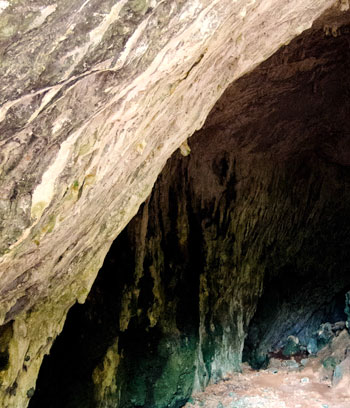 The cave of Skoteino is located in the Municipality of Chersonissos, 23km east of Heraklion and 1 km northwest of Skoteino village at an altitude of 225m. The cave of Skoteino is one of the most important caves in Crete, from speleological and archaeological point of view. The worship use of the cave from 1900 BC to at least the 4th AD century is confirmed through the excavation findings.
The cave of Skoteino is located in the Municipality of Chersonissos, 23km east of Heraklion and 1 km northwest of Skoteino village at an altitude of 225m. The cave of Skoteino is one of the most important caves in Crete, from speleological and archaeological point of view. The worship use of the cave from 1900 BC to at least the 4th AD century is confirmed through the excavation findings.
The cave was first explored in 1933 by Evans, while the archaeologist K. Davaras excavated the cave in 1962 and discovered pieces of vases, ceramic needles, lamps and three bronze figurines of the late Minoan era representing adoration in the famous worshiping attitude with the right hand on the forehead and other findings dating from the Minoan to the Roman period.
Paul Faure, researcher and speleologist, formulated the theory that the cave of Skoteino was the famous Labyrinth of Minotaur in Knossos, where the legendary hero Theseus, leading 7 young women and 7 young men, killed the Minotaur and succeeded –thanks to Ariadne’s clew– to find the way out. He believed that the cave was a place of initiation of youth, where, during the Minoan Era, the believers worshiped at least three deities: the goddess-mother, the goddess-virgin and a young god. The faces and bodies of these deities are depicted on the blackened forms of the rocks and stalagmites of the cave (source: Paul Faure, 1996, Holy Caves of Crete).
Inside the cave, on the right side of the entrance, there are remnants of a Byzantine small temple dedicated to Agia Paraskevi, which was destroyed by the Turks and rebuilt over the cave in 1840 AD. Today, there is a small square in the wide area of the church where a feast is held on 26th of July. The entrance in order to get into the cave is quite easy, as there are steps leading through the mouth of a large green doline (sinkholes) where the cave opens.
The opening of the cave is enormous and awe-inspiring. It is an area of about 2,500 square meters – 450m of which are a tourist route– 170 meters deep, 36 meters wide and up to 47 meters high. Past the entrance, there is a huge magnificent hall, the “Great Temple” which is 130m long, 33m wide and the height is 30m.
There are impressive clusters of stalagmites and stalactites whose shapes resemble animal forms and possibly it is the result of human intervention. Also, there are two or three troughs at stalagmites. The water falling from the stalactites is concentrated in them as the drip continues until today. In these troughs, the believers put their hands in and washed them. It was a kind of cleansing before they made their sacrifices. This room had a worshiped use while the main goddess be worshiped there, was the goddess Vritomartis, the protector of fishermen that worshiped in Crete.
The next room is the “Altar” which is smaller in dimensions (24×8.5×25) and there are indications that this room was used for sacrifices. There is also a crack on the floor in which the believers offered their bids (oil, blood, milk) to the deity.
Almost all the visitors that come to the cave stop their tour at this point because in order to go on one needs to use speleological equipment due to its inaccessible terrain. Below, there are other halls with worship character such as the “Hall of Aditos” and the “Hall of Worship” which is a hall of unique beauty that resembles a dome with spectacular natural decoration in each centimeter being full of colors. The “Prayer Hall” follows and finally a small narrow chamber opens which the locals call “Chapel”.